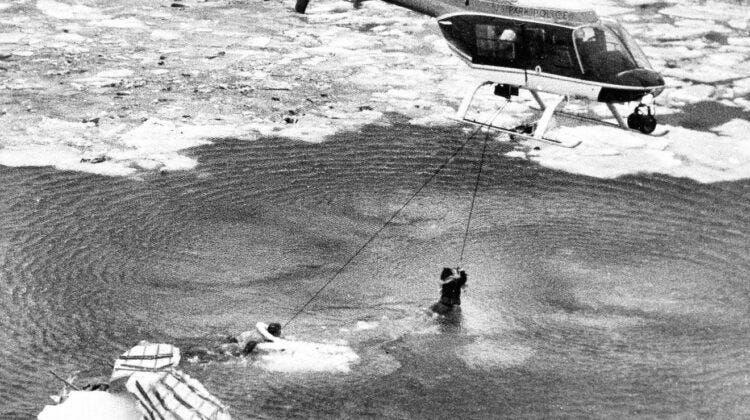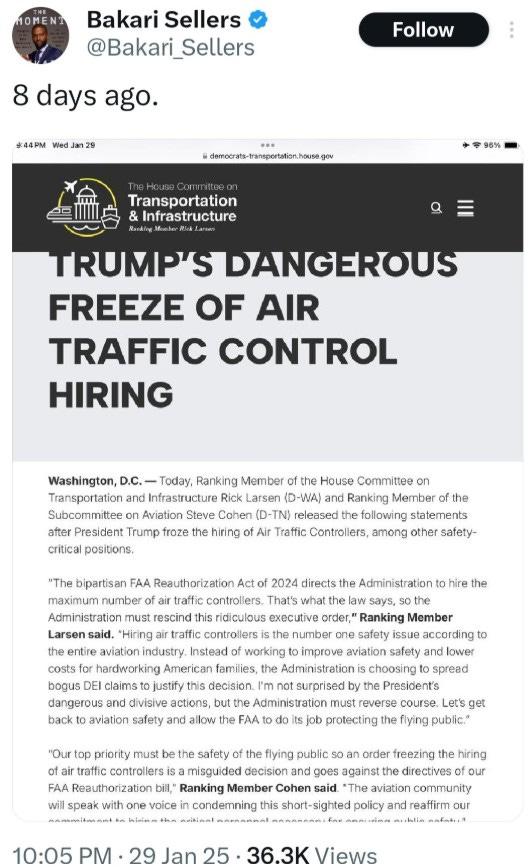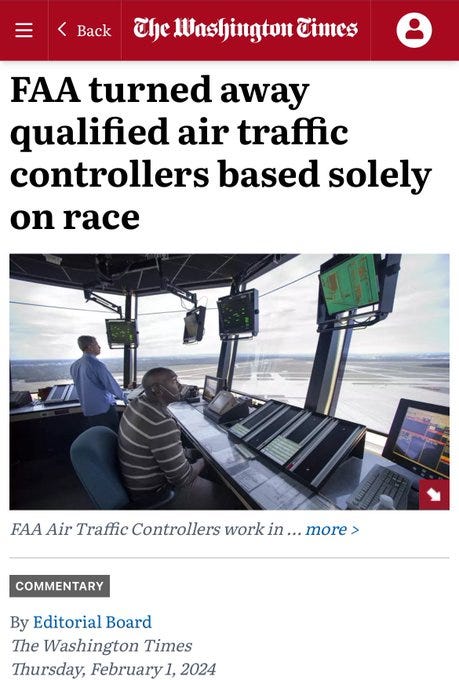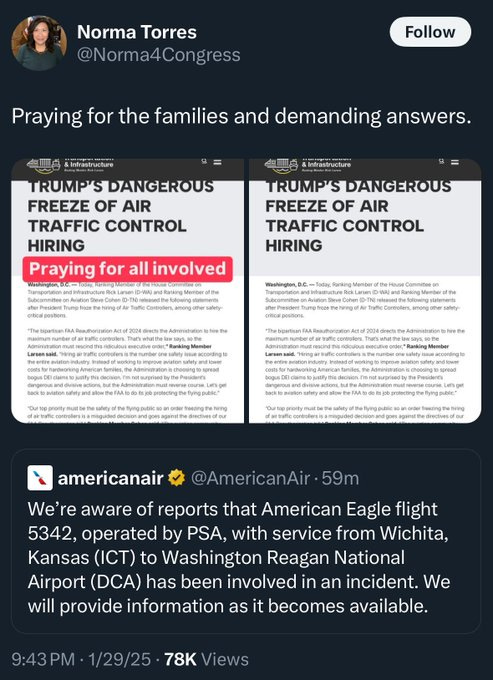Comparing Reactions to Two DC-Area Plane Accidents
Aside from 9/11, the last major air crash at Washington's Reagan (formerly National) Airport occurred 43 years ago. Sadly, we have a new one. And the media reactions are starkly different.
A favorite area restaurant of mine is located on the north end of Alexandria, Virginia’s “Old Town.” Now called Jula’s on the Potomac, formerly Cafe 44, it is nestled at the top of an office building with expansive views of the Potomac River, minutes south of Washington’s Reagan Airport.
I love sitting at an outdoor table on a beautiful sunset, even with the constant distractions of commercial aircraft taking off or landing at Washington’s Ronald Reagan National Airport. The early evening hours are hectic, with flights taking off or landing by the minute, flying over pleasure and police boats, water taxis, and traveling between busy highways and historic communities parallelling the river.
At the same time, it’s also easy to spot helicopters flying along the Maryland side of the river. Sometimes, they’re the blue and white US Park Police helicopters, but also frequently are military helicopters, flying low and slow past Joint Base Bolling, then the Delacarlia wastewater treatment plant, not far from busy I-295, as they head to or from the Pentagon, just north of the airport. It’s mesmerizing, in a way.
An Army aviation brigade at expansive Fort Belvoir neighbors George Washington’s Mount Vernon estate south of the infamous I-495/I-95 beltway. Another expansive military facility, Marine Base Quantico, is a few more miles to the south and west. Helicopters and the occasional V-22 Osprey are almost as ubiquitous, doing training missions and shuttling personnel between the Pentagon or points north, just a few miles north of Reagan Airport and the aforementioned military facilities.
Thanks to Reagan Airport, the Pentagon, multiple military bases, and even the White House, the Potomac River is a busy, diverse commercial and military aircraft highway.
To assuage constituents complaining about helicopter noise, the exclusively Democratic DC congressional delegation has pushed the Pentagon to use the Potomac and I-395 in Virginia as flight patterns to minimize the impact of neighborhood noise.
For three years, my wife and I lived in a historic community (Fairlington Villages, America’s first “planned community”) that straddled what the locals call Shirley Highway (I-395) for a while. I often stepped outside on the deck to watch helicopters, sometimes two or three at a time, slowly gaining altitude as they flew over the highway, either coming in for a landing at the Pentagon or heading back to Belvoir or Quantico. An orange Coast Guard helicopter was a frequent site.
“Sound of freedom,” I often muttered. The loud, thumping sounds of military helicopters flying by never bothered me. Sometimes, we’d see what looked like Marine One fly by, likely on a training mission. Where we live now, it is fun to see and hear the occasional military helicopter descend over our house on approach to land at Mount Weather, the federal government’s “continuity of government” facility nestled into the 73-mile-long Shenandoah Mountain that serves as the Shenandoah Valley’s eastern border, the first “wave” of the Blue Ridge Mountains. It’s where congressional leaders were reportedly delivered on 9/11.
And no, I don’t have special access. Hopefully, I’ll never need it.
Mount Weather is also no stranger to commercial airline crashes.
Most people don’t know that DC has jurisdiction over the Potomac River north of the beltway, not Virginia. Virginia and Maryland share jurisdiction south of it. However, all three jurisdictions work seamlessly together to manage the constant flow of people, planes, helicopters, boats, and vehicular traffic in the populous region. And it’s all hands on deck when bad things happen, as they did last night with the tragic crash of an American Airlines flight from Wichita, Kansas, that was trying to land at the shorter and less-frequently used of Reagan’s two runways (number 33) on a clear and blustery evening.
My wife and I drove near the airport and past the Pentagon after a day in and around the Capitol, just as the crash occurred. We were unaware. There were no survivors. Sixty-four people are dead, along with three soldiers flying a Blackhawk helicopter on a night-time training mission back to Fort Belvoir.
It was the most significant accidental airplane crash at Reagan Airport since January 13, 1982. I don’t include the US Air crash into the Pentagon on 9/11 because that was a hijacking and a terrorist attack, not an accident, even as it was no less horrific or tragic and, in some ways, worse.
Everything is preventable until it’s not.
On that sad and wintery day in early 1982, Air Florida Flight 90 was de-iced, then waited and waited to take off northbound under wet, freezing conditions. The takeoff was delayed so long that the wings began to ice over. As the plane struggled for altitude, the tail dragged across 14th Street Bridge, the major I-395 traffic artery clogged with commuters slowly inching their way into Washington from northern Virginia before crashing into the icy Potomac near the Jefferson Memorial. Several cars were destroyed, their drivers and passengers were killed, and over 70 flight passengers perished in the watery and wintery crash.
Later that afternoon, during the evening rush, two crowded Washington Metro trains collided underground, resulting in the subway system’s first-ever fatalities. For those living and working in the DC area at the time, the combination of the plane and metro crashes and a nasty winter storm is a memory seared into our minds.
And the different reactions to those crashes are stark, even repugnant.
When the 1982 crash tragically happened, we were amazed by the first responders, including one Lenny Skutnik, who was a bystander watching a woman flailing in the icy Potomac, increasingly unable to grab the ladder of a hovering rescue copter. Skutnik, a Congressional Budget Office printing shop employee, jumped into the Potomac, swam to Priscilla Terado, and brought her to the riverbank. The modest and humble Skutnik was rightly hailed as a hero and was invited by President Reagan to his State of the Union Address, sitting next to First Lady Nancy Reagan in the US House visitor’s gallery. Skutnik demonstrated that every American can be a “first responder” when duty calls.
It was the president's first acknowledgment of a guest during a SOTU speech. Now, it is a regular feature of almost every SOTU.
The first responders to last night’s tragic collision battled dark and gusty conditions with water temperatures in the high 30-degree range in a river famous for undercurrents. They were no less heroic in their efforts to find and rescue survivors and recover evidence and remains of the deceased for federal investigators to begin their work to find the cause.
And it took 30 minutes for some in the media to blame President Donald Trump. On social media, of course.
But Rupar, a cretinous partisan and grifter-for-clicks who pretends to be a journalist, wasn’t alone. Former South Carolina Democratic legislator and author Bakari Sellers withdrew this post on X, but not before Erick Erickson and others captured it. And many other “journalists” jumped in with similar posts. Sellers, to his credit, apologized for the post.
Who said this was an air traffic control failure? And is Mr. Sellers sure that he wants to go there? It’s a game that abhors me, and I’m not making the rules. But I’m happy to enforce these new rules on those that make ‘em. There is no indication that air traffic control was a problem in this week’s tragic accident.
Just as bad are the armchair quarterbacks who feel compelled to propound blame and theories without knowledge or engage in immediate conspiracy theories. Catturd is a popular anonymous social media “influencer” on the right who has joined the grifting hoards on the spectrum as a leading conspiracy theorist. I generally don’t like anonymous social media accounts, even though I understand the necessity of many of them. These accounts allow people with unique expertise and experiences to share valuable information with minimal risk of retribution.
“Casually?” Good God, what insensitivity and lunacy.
And when you think Members of Congress can get no worse, US Rep. Norma Torres (D-CA) informs you otherwise.
When Air Florida 90 happened, I don’t recall anyone rushing to blame Ronald Reagan for it (I’m sure some tried in the pre-social media era, but the media was more responsible in their “gatekeeping” role back then). It was the weather and a fateful decision to allow the plane to take off despite the interminable delay after deicing. It was a tough call, one that I’m sure many regret. That was despite the famous firing of thousands of nearly 12,000 striking air traffic controllers in August 1981—months into Reagan’s presidency.
Sometimes, we should be grateful for the inconveniences of canceled flights under such circumstances. It’s supposed to be “safety first,” after all.
Also offensive are the mostly right-wing numb nuts criticizing or demonstrating a lack of confidence in the agencies involved in the response and the investigations. The National Transportation Safety Board is a stellar organization. We should trust institutions like the NTSB, military investigators, and even Congress to investigate what happened so it never happens again. Chairman Sam Graves (R-MO) of the House Transportation and Infrastructure Committee is a solid professional, a serious legislator, and a pilot. Sen. Ted Cruz (R-TX) is chair of the Senate Commerce, Science, and Transportation Committee, among the more bipartisan panels in the “upper body.” They both have excellent professional staff.
Think about all the jurisdictions (Maryland, DC, Virginia, the federal government, and various local entities) and military and government installations nearby: the Pentagon. Reagan Airport. Fort Belvoir. Marine Base Quantico. Andrews Air Force Base. Mount Weather, near where I live. Two other DC-area airports (Dulles and Baltimore-Washington). Even the White House. It’s a miracle that an accident hasn’t happened before. There have been close calls.
Everyone needs to check their politics, pray for and support the victims and their families, trust the investigators, and wait for the truth to emerge. This is not the first air disaster in our region, and it won’t be the last. But we need to learn from it to minimize the chances that it happens again. President Trump and Secretary of Transportation Sean Duffy are correct—it shouldn’t have happened.
Meanwhile, we pray for and support the victims’ families and praise the first responders for their thankless work.
Had I been sitting at Jula’s then, I would have had a front-row seat to the disaster. I’m glad I wasn’t there.











Interesting aviation history.